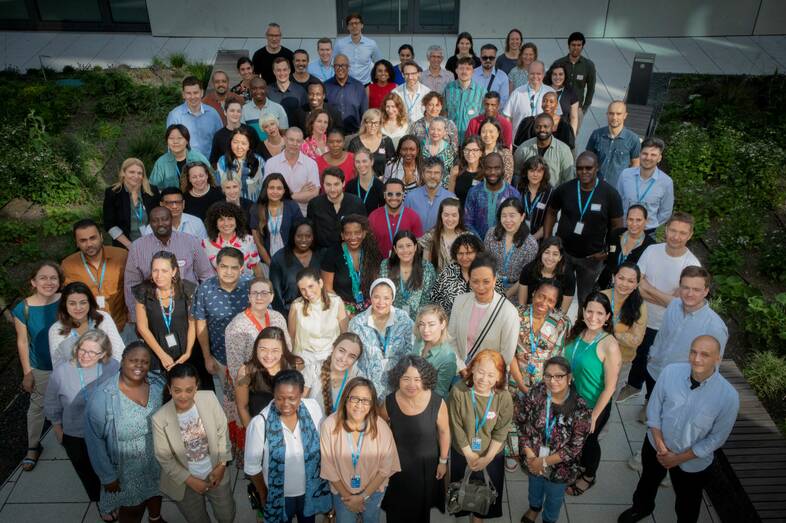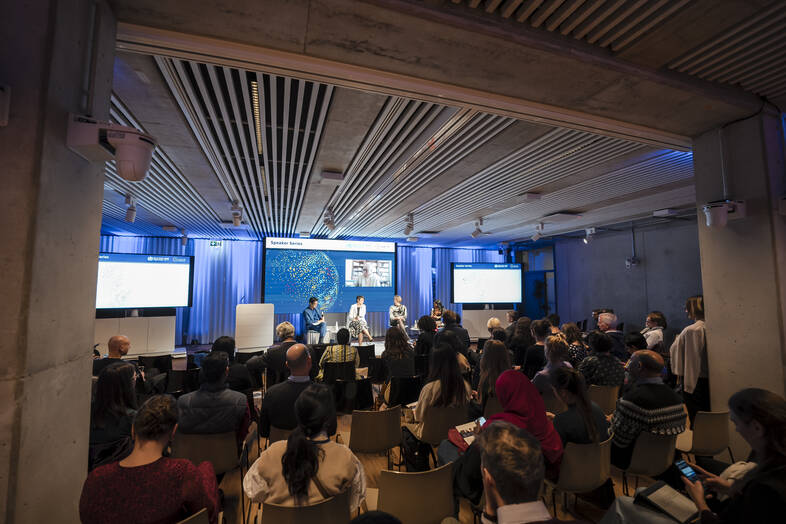In Portrait | WHO Hub for Pandemic and Epidemic Intelligence – Supporting countries to make better decisions for public health emergencies

A little more than three years ago, in September 2021, then-German Chancellor Angela Merkel and World Health Organization Director-General Dr Tedros Adhanom Ghebreyesus inaugurated the newly established WHO Hub for Pandemic and Epidemic Intelligence in Berlin. The Hub is one response by the international community recognising the need to strengthen approaches to decision-making – as evidenced by the COVID-19 pandemic.
Based in Kreuzberg’s Prinzessinnenstraße, the Hub aims to enable World Health Organization Member States to better detect, monitor and respond to health threats. The Hub provides a workspace for 120 people, with half of these seats reserved for visiting experts from Member States and partner organizations who work together to help design the technologies, develop the data standards, and build networks to generate public health intelligence before, during and after emergencies. The Hub is part of the Geneva headquartered World Health Organization Health Emergencies Programme with all the World Health Organization’s Member States as its primary stakeholders. The Hub sees its role in the global health ecosystem to “support countries to generate better data and use advanced analytics to make better decisions to prevent and prepare for future health emergencies”, wrote Dr Chikwe Ihekweazu, Deputy Executive Director of World Health Organization’s Emergencies Programme, on the occasion of the Hub’s 3-year anniversary.
Collaborative Surveillance: a guiding principle
Establishing Collaborative Surveillance has been one of the Hub’s main tasks in its first years. This approach to data sharing helps countries to detect outbreaks earlier and prevent them from spreading by strengthening not only country capacities but also national, regional, and global collaboration. Collaborative Surveillance serves as one part of the World Health Organization’s framework to strengthen the global architecture for health emergency preparedness, response and resilience (HEPR). The goal now is to mainstream collaborative surveillance into national strategies – in other words, to encourage Member States to include the concept in their own planning, explained Dr. Ihekweazu.


Mpox: Modelling collaboration
A current emergency that underscores the hub’s importance is the outbreak of mpox. It is the second mpox outbreak of international concern in two years. The outbreak brings out the Hub’s work to “strengthen preparedness and respond quickly to emerging and re-emerging health threats,” Dr Ihekweazu said.
One example of the Hub’s effectiveness is the Collaboratory initiative, to facilitate faster, more comprehensive data analysis for emerging disease threats. The experience with COVID-19 has shown how fragmented disease analysis capacities can be, therefore the World Health Organization is providing a digital platform where analysts and modellers can exchange learnings before, during and after times of a health crisis. With the mpox outbreak, a community of practice working on analytics and modelling for mpox was immediately brought together to exchange methods and data sources. While it already existed, it was re-activated and has rapidly grown to build different transmission patterns and interventions into models to support decision-making. In addition to ad-hoc communication between members, the community of practice offers webinars to exchange early results and challenges. This has helped to ensure that methods include the latest discussions and existing data sources, e.g. the recently extracted epidemiological parameters on Mpox that are regularly updated and can be used.
The International Pathogen Surveillance Network (IPSN) initiative is working to enhance global collaboration to detect and understand pathogens, including viruses and their often-rapid mutations. mpox serves as a good use case, Josefina Campos, Unit Head of Genomics and Analytics, explained. As the virus has mutated, genomic surveillance is key to monitoring changes in the disease transmission and to understand how the different clades of the virus have spread internationally. Since its launch in May 2023, IPSN has quickly grown to include 200 partners across 71 countries. Communities of practice and projects have been built across borders, to ensure preparedness before a crisis hits.
Early warning
Another key initiative which has grown significantly throughout the last year is the Epidemic Intelligence from Open Sources (EIOS). EIOS supports and enhances the early detection capabilities of Member States by connecting global experts and enabling them to utilise publicly available data for swift, evidence-based action. Simply put, EIOS serves as an early warning community and system, so that analysts can spot signals related to a potential emergency, such as a new disease outbreak, early – based on their monitoring of open-source information such as media reports. “If, for example, media reports are captured of infants in a location experiencing a specific symptom or set of symptoms, this can be rapidly investigated to validate and understand the situation and inform appropriate communication and action,” said Philip AbdelMalik, Unit Head for Intelligence Innovation and Integration. Due to information inflation, monitoring and triaging is a 24/7 job that can greatly benefit from advances in technology, he pointed out. The Hub supports this work by providing enabling solutions (through the EIOS System) and connecting the community of practice to strengthen expertise, collaboration and information exchange.
Expanded through the Hub, EIOS has greatly grown its user base since 2020 and now serves almost 100 Member States and over 25 regional and international organizations as of Autumn 2024.
Stronger roots for health diplomacy in Berlin
Being based in Berlin is an enriching opportunity for both the Hub and the German public health ecosystem, stressed Dr Ihekweazu. With the Charité and its Center for Global Health as well as the Robert Koch Institute, the Hub has strong scientific partners in Berlin, and benefits from these environments. Leveraging the World Health Organization’s convening power, it has helped to put Berlin on the global health map even more prominently; over the last three years, hosting more than 30 events with participants from 196 institutions from across the world. There are also synergies, for example, with the World Health Summit, an annual event in Berlin that brings together international experts in global health.
Based in Berlin, the WHO Hub for Pandemic and Epidemic Intelligence is for the world.
Related Links:



